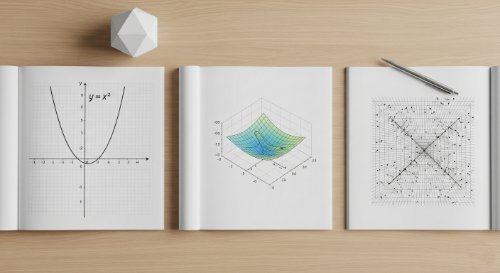Introduction to Numerical Methods (Undergraduate Foundation)
51
9 hrs
 MTH 201: Mathematical Methods IThis learning track delivers the complete mathematical toolkit required for a university-level science, engineering, or computing degree. It systematically covers the entire MTH 201 curriculum, building from the foundational principles of single-variable calculus - functions, limits, continuity, and differentiability - to the advanced methods of multivariable calculus, infinite series, numerical methods, and ordinary differential equations. This is the definitive preparation for advanced quantitative study.
This programme is designed for second-year students offering MTH 201 at Obafemi Awolowo University, Ile-Ife, Nigeria. It is also helpful for any student in a STEM field - including physics, engineering, and computer science - who requires a rigorous and comprehensive command of calculus and its applications.
This track delivers a full skill set in mathematical analysis and applied problem-solving. Graduates will be able to solve a wide range of problems, from optimising multivariable functions to modelling dynamic systems with differential equations and testing the convergence of infinite series. This programme directly prepares students for success in advanced courses in vector calculus, partial differential equations, and real analysis, providing the necessary foundation for a career in engineering, data science, or theoretical physics.
MTH 201: Mathematical Methods IThis learning track delivers the complete mathematical toolkit required for a university-level science, engineering, or computing degree. It systematically covers the entire MTH 201 curriculum, building from the foundational principles of single-variable calculus - functions, limits, continuity, and differentiability - to the advanced methods of multivariable calculus, infinite series, numerical methods, and ordinary differential equations. This is the definitive preparation for advanced quantitative study.
This programme is designed for second-year students offering MTH 201 at Obafemi Awolowo University, Ile-Ife, Nigeria. It is also helpful for any student in a STEM field - including physics, engineering, and computer science - who requires a rigorous and comprehensive command of calculus and its applications.
This track delivers a full skill set in mathematical analysis and applied problem-solving. Graduates will be able to solve a wide range of problems, from optimising multivariable functions to modelling dynamic systems with differential equations and testing the convergence of infinite series. This programme directly prepares students for success in advanced courses in vector calculus, partial differential equations, and real analysis, providing the necessary foundation for a career in engineering, data science, or theoretical physics.
This learning track delivers the complete mathematical toolkit required for a university-level science, engineering, or computing degree. It systematically covers the entire MTH 201 curriculum, building from the foundational principles of single-variable calculus - functions, limits, continuity, and differentiability - to the advanced methods of multivariable calculus, infinite series, numerical methods, and ordinary differential equations. This is the definitive preparation for advanced quantitative study. This programme is designed for second-year students offering MTH 201 at Obafemi Awolowo University, Ile-Ife, Nigeria. It is also helpful for any student in a STEM field - including physics, engineering, and computer science - who requires a rigorous and comprehensive command of calculus and its applications. This track delivers a full skill set in mathematical analysis and applied problem-solving. Graduates will be able to solve a wide range of problems, from optimising multivariable functions to modelling dynamic systems with differential equations and testing the convergence of infinite series. This programme directly prepares students for success in advanced courses in vector calculus, partial differential equations, and real analysis, providing the necessary foundation for a career in engineering, data science, or theoretical physics.
Course Chapters
1. Introduction2
This chapter sets the foundation for the entire course. It defines what numerical methods are, explains why they matter, and outlines when and why they are used instead of analytical techniques. We establish the scope, assumptions, and limitations that shape all subsequent methods. If you skip this, you will misapply the rest. By the end of this chapter, you should be able to: – Distinguish between analytical and numerical solutions. – Identify problems best suited for numerical methods. – Recognise key sources of numerical error. – Understand the structure of a typical numerical method.
Chapter lessons
2. Equations in One Variable (1)42
Introduction, existence of solutions, and bisection method of numerical solutions of equations in one variable.
Chapter lessons
2-1. Introduction10:11
2-3. Overview of the bisection method7:11
Advantages and disadvantages of the bisection method of solution of equations in one variable.
3. Equations in One Variable (2)23
Numerical solutions of equations in one variable - Newton-Raphson's iterative method.
Chapter lessons
3-1. Newton's method28:57
Newton's method of solution of equations in one variable.
3-2. Overview of Newton's method6:17
Advantages and disadvantages of Newton's method solution of equations in one variable.
4. Integration (1)21
Introduction to numerical integration of single-variable functions. Trapezoidal rule.
Chapter lessons
4-1. Introduction17:23
An overview of the theory of numerical integration methods.
4-2. Trapezoidal rule9:48
Integration by the trapezoidal rule.
5. Integration (2)13
Simpson's 1/3 rule of numerical integration of single-variable functions.
Chapter lessons
5-1. Simpson's rule6:50
Integration by Simpson's 1/3 rule.